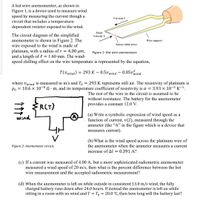
Introductory Circuit Analysis (13th Edition)
13th Edition
ISBN: 9780133923605
Author: Robert L. Boylestad
Publisher: PEARSON
expand_more
expand_more
format_list_bulleted
Concept explainers
Question
thumb_up100%
I solved #1, but I need help with #2 and #3 please! Thank you!

Transcribed Image Text:1.
Answer part (c) of the problem. Show work.
2.
Consider part (d) of the problem. How fast would the wind need to be to run
the same battery down in 22 hours?
3.
Which wind is faster? Wind that cools the anemometer to 0°C or wind
that increases the power output of the resistive wire by 4.00%?

Transcribed Image Text:A hot wire anemomenter, as shown in
Figure 1, is a device used to measure wind
speed by measuring the current though a
circuit that includes a temperature-
Current I
dependent resistor exposed to the wind.
Fluid
The circuit diagram of the simplified
anemometer is shown in Figure 2. The
wire exposed to the wind is made of
platinum, with a radius of r = 4.00 µm,
and a length of l = 1.60 mm. The wind-
speed chilling effect on the wire temperature is represented by the equation,
Velocity U
Wire support
Sensor (thin wire)
Figure 1: Hot wire anemometer.
T(vwina) = 293 K – 0.5vwind – 0.05vwind
%3D
-
where vwind is measured in m/s and To
= 293 K represents still air. The resistivity of platinum is
Po = 10.6 × 10-8 N · m, and its temperature coefficient of resistivity is a = 3.93 × 10-3 K-1.
The rest of the wire in the circuit is assumed to be
without resistance. The battery for the anemometer
provides a constant 12.0 V.
3 RCT)
(a) Write a symbolic expression of wind speed as a
function of current, v(1), measured through the
ammeter (the “A" in the figure which is a device that
measures current).
wind
(b) What is the wind speed across the platinum wire of
Figure 2: Anemometer circuit.
the anemometer when the ammeter measures a current
increase of AI = 0.391 A?
(c) If a current was measured of 4.00 A, but a more sophisticated radiometric anemometer
measured a wind speed of 20 m/s, then what is the percent difference between the hot
wire measurement and the accepted radiometric measurement?
(d) When the anemometer is left on while outside in consistent 13.0 m/s wind, the fully
charged battery runs down after 24.0 hours. If instead the anemometer is left on while
sitting in a room with no wind and T = T, = 20.0 °C, then how long will the battery last?
Expert Solution
This question has been solved!
Explore an expertly crafted, step-by-step solution for a thorough understanding of key concepts.
This is a popular solution
Trending nowThis is a popular solution!
Step by stepSolved in 6 steps

Knowledge Booster
Learn more about
Need a deep-dive on the concept behind this application? Look no further. Learn more about this topic, electrical-engineering and related others by exploring similar questions and additional content below.Similar questions
- 01011003 - Electrical/Electronic System Fundamentals - Personal - Microsoft Edge https://college.fordservicetraining.com/SCORM/Shell.html?id=d0c4da2b-dd62-4326-b80f-5b12de237f26&ver=2004 Electrical Fundamentals Which of the following is considered a pushing force? A) Resistance B) Voltage C) Current D) All of the above Back Next 41 of 52 O Type here to search O000arrow_forwardin the circuit, the voltage across R1 in volts is ___ in the circuit, the voltage across R2 in volts is ___ in the circuit, the voltage across R3 in volts is ___arrow_forward#2 hello can you find , ir1, ir2 ir3 rt, it ,and pt . Thank you please show me how to do my homeworkarrow_forward
arrow_back_ios
arrow_forward_ios
Recommended textbooks for you
 Introductory Circuit Analysis (13th Edition)Electrical EngineeringISBN:9780133923605Author:Robert L. BoylestadPublisher:PEARSON
Introductory Circuit Analysis (13th Edition)Electrical EngineeringISBN:9780133923605Author:Robert L. BoylestadPublisher:PEARSON Delmar's Standard Textbook Of ElectricityElectrical EngineeringISBN:9781337900348Author:Stephen L. HermanPublisher:Cengage Learning
Delmar's Standard Textbook Of ElectricityElectrical EngineeringISBN:9781337900348Author:Stephen L. HermanPublisher:Cengage Learning Programmable Logic ControllersElectrical EngineeringISBN:9780073373843Author:Frank D. PetruzellaPublisher:McGraw-Hill Education
Programmable Logic ControllersElectrical EngineeringISBN:9780073373843Author:Frank D. PetruzellaPublisher:McGraw-Hill Education Fundamentals of Electric CircuitsElectrical EngineeringISBN:9780078028229Author:Charles K Alexander, Matthew SadikuPublisher:McGraw-Hill Education
Fundamentals of Electric CircuitsElectrical EngineeringISBN:9780078028229Author:Charles K Alexander, Matthew SadikuPublisher:McGraw-Hill Education Electric Circuits. (11th Edition)Electrical EngineeringISBN:9780134746968Author:James W. Nilsson, Susan RiedelPublisher:PEARSON
Electric Circuits. (11th Edition)Electrical EngineeringISBN:9780134746968Author:James W. Nilsson, Susan RiedelPublisher:PEARSON Engineering ElectromagneticsElectrical EngineeringISBN:9780078028151Author:Hayt, William H. (william Hart), Jr, BUCK, John A.Publisher:Mcgraw-hill Education,
Engineering ElectromagneticsElectrical EngineeringISBN:9780078028151Author:Hayt, William H. (william Hart), Jr, BUCK, John A.Publisher:Mcgraw-hill Education,

Introductory Circuit Analysis (13th Edition)
Electrical Engineering
ISBN:9780133923605
Author:Robert L. Boylestad
Publisher:PEARSON

Delmar's Standard Textbook Of Electricity
Electrical Engineering
ISBN:9781337900348
Author:Stephen L. Herman
Publisher:Cengage Learning

Programmable Logic Controllers
Electrical Engineering
ISBN:9780073373843
Author:Frank D. Petruzella
Publisher:McGraw-Hill Education

Fundamentals of Electric Circuits
Electrical Engineering
ISBN:9780078028229
Author:Charles K Alexander, Matthew Sadiku
Publisher:McGraw-Hill Education

Electric Circuits. (11th Edition)
Electrical Engineering
ISBN:9780134746968
Author:James W. Nilsson, Susan Riedel
Publisher:PEARSON

Engineering Electromagnetics
Electrical Engineering
ISBN:9780078028151
Author:Hayt, William H. (william Hart), Jr, BUCK, John A.
Publisher:Mcgraw-hill Education,